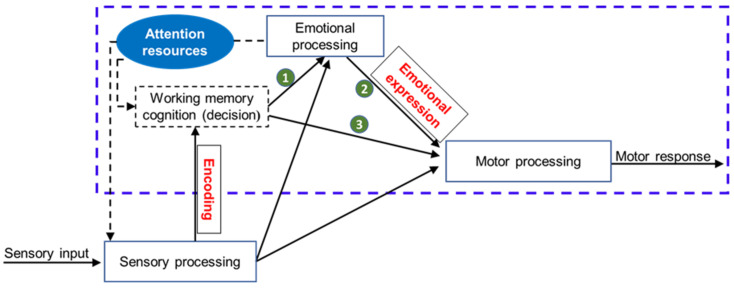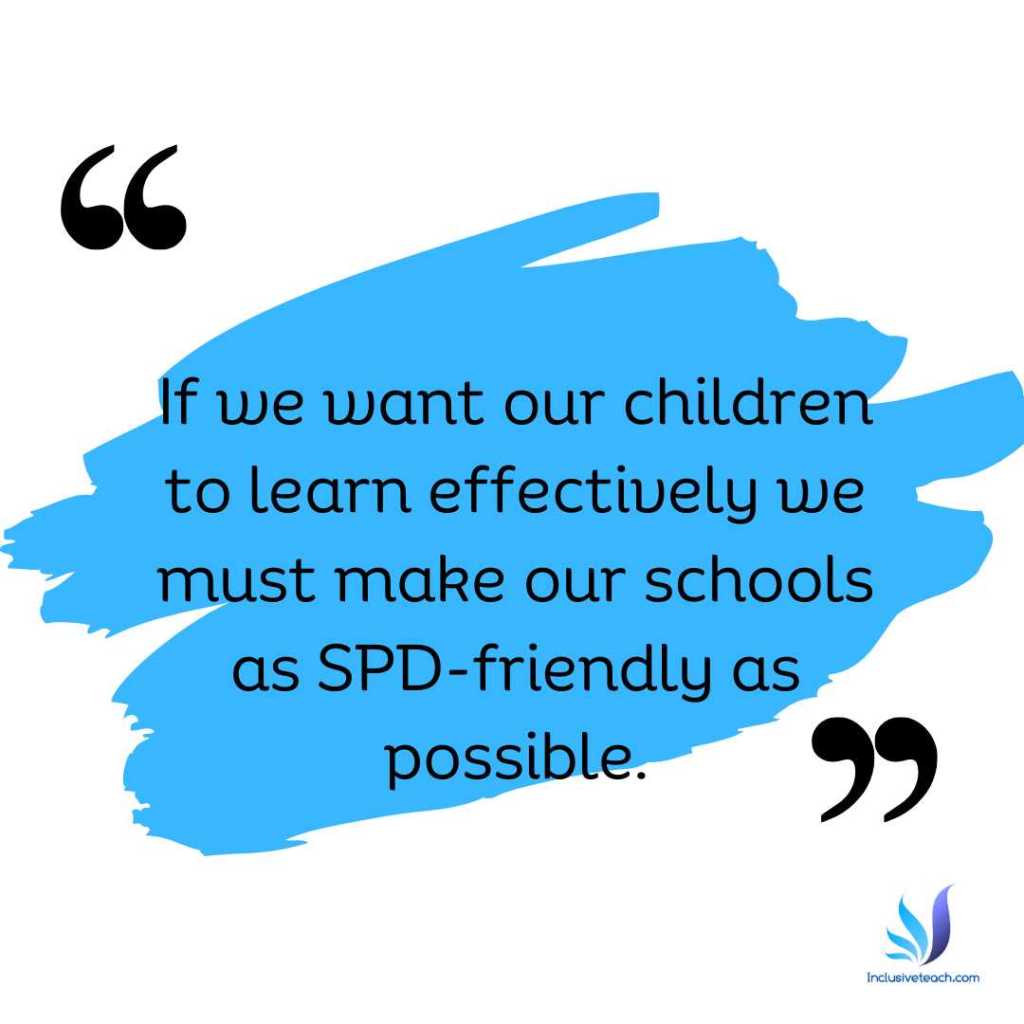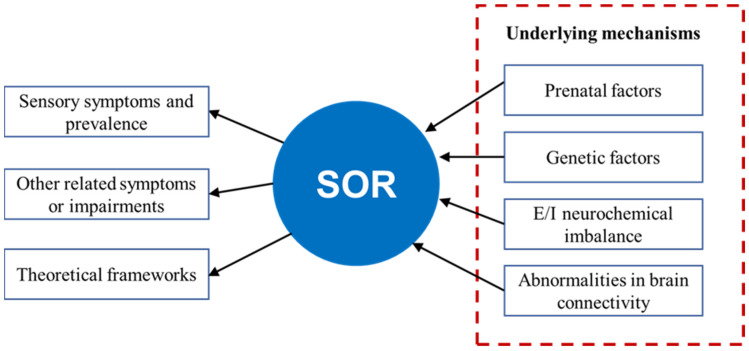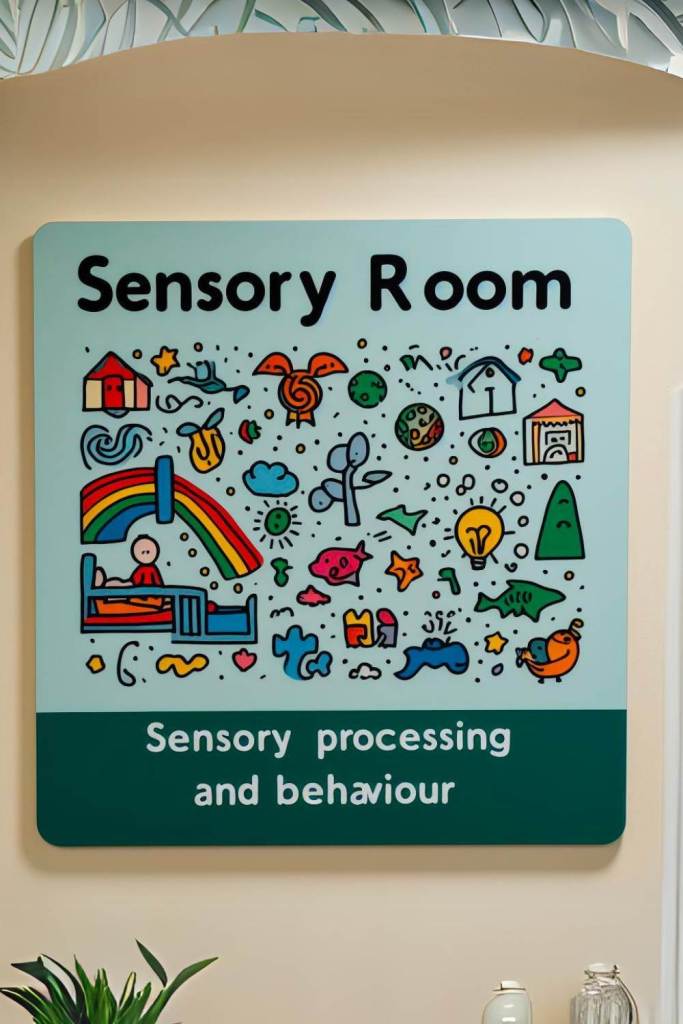Sensory Processing Disorder Links to Childhood Behaviour
As behaviour lead one of the most frequent questions that I often get asked is: “How does sensory input impact behaviour?” To answer this question I need the support of Sensory OTs and assessment tools. To support the child we need to delve into the intricacies of sensory processing and its relationship with human behaviour. This article aims to provide an in-depth understanding of this subject and offer guidance to parents and teachers who support children with sensory processing challenges.
Although sensory processing disorder is not a new condition and indeed has been talked about in depth since the publication of “The Out Of Sync Child“, it has gained more attention in recent years. Awareness of this condition has increased, and more people are seeking treatment for it. There are various treatment options available, including occupational therapy, sensory integration therapy, and medication. With the right treatment, many people with sensory processing noise can learn to manage their symptoms and improve their quality of life.
Introduction to Sensory Processing
Sensory processing refers to how our nervous system receives, organises, and interprets information from our senses. These senses include the traditional five senses—touch, sight, hearing, smell, and taste—as well as three lesser-known ones—proprioception (body awareness), vestibular (balance and movement), and interoception (internal bodily sensations). For most people, sensory processing happens automatically. Our brains efficiently process the sensory inputs we receive, allowing us to respond appropriately to our environment. However, for some—particularly many children with conditions like Autism (ASD) or Attention Deficit Hyperactivity Disorder (ADHD)—this process can be disrupted, leading to sensory processing disorder (SPD). As you can see from the figure below this impacts on a huge range of the child’s actions, emotions and responses. If we want our children to learn effectively we must make our schools as SPD friendly as possible.

The Link Between Sensory Processing and Behaviour
Every behaviour, or action, we undertake is a form of communication, and for children with sensory processing challenges, their behaviours often reflect their internal or external sensory experiences. There’s a profound connection between sensory input and behaviour because the sensory information we receive and interpret forms the basis of our reactions and interactions with the world around us. When sensory input is processed correctly, it enables appropriate behavioural responses. But when a child has SPD, their sensory input isn’t organised effectively, which can result in behavior that seems inappropriate or out of context. For example, a child who is oversensitive to touch might react aggressively to a light pat on the back, not because they’re inherently aggressive, but because their sensory system perceived the touch as a threat or a source of pain.
Sensory Overload and Meltdowns
One of the most noticeable impacts of sensory processing difficulties on behaviour is the occurrence of what are generally known as meltdowns. A sensory meltdown is an intense response to overwhelming sensory input. It’s not a tantrum or a result of “being naughty” but a neurological event that is out of the child’s control. Children experiencing sensory overload may have meltdowns that involve crying, biting, screaming, throwing things, or even aggressive behaviour towards others in the area (often those people are trying to help but may be exacerbating the stress for the individual). It’s essential to understand that during a meltdown, children aren’t acting out—they’re reacting to the overwhelming sensory input they’re struggling to process – They are trying to escape, regulate and find safety.

Sensory Seeking and Avoiding Behaviours
Children with sensory processing difficulties may exhibit sensory-seeking or sensory-avoiding behaviours.
Sensory seekers are children who crave more sensory input. They might be constantly on the move, love spinning or jumping, enjoy loud noises, or seek out intense tastes or textures. While these behaviours might seem disruptive, they’re a way for sensory seekers to self-regulate and satisfy their need for additional sensory stimulation.
Sensory avoiders are easily overwhelmed by sensory input and will go to great lengths to avoid it. They might cover their ears in response to normal levels of noise, resist wearing certain types of clothing due to how it feels, or be extremely picky eaters, avoiding foods with specific textures or flavours. These behaviours are coping mechanisms that help sensory avoiders limit their exposure to sensory stimuli that feel overwhelming.
In schools we often struggle to manage these behaviours due to the environmental and social barriers inherent in the education system that is designed for children who will sit and attend in a small classroom for an extended period of time.
Strategies to Manage Sensory-Related Behaviours
Understanding the link between sensory input and behavior allows parents and teachers to implement strategies that help children with SPD. Here are a few key approaches:
- Create a Sensory-Friendly Environment: Try to control the sensory experience in your child’s environment as much as possible. This could involve using noise-canceling headphones to block out overwhelming noise, providing fidget toys for sensory seekers, or creating a quiet, dimly-lit space for when they feel overwhelmed.
- Use a Sensory Diet: A sensory diet is a set of activities tailored to a child’s specific sensory needs. It can help them stay focused and organised throughout the day. An occupational therapist can help design a sensory diet that meets your child’s unique needs.
- Teach Coping Strategies: Teach your child strategies to cope with sensory overload. This might involve deep breathing exercises, using a weighted blanket, or squeezing a stress ball.
- Educate Others: Educate family members, teachers, and anyone else interacting with your child about SPD. Help them understand your child’s sensory needs and how they impact their behavior.
Types of Sensory Processing Issues
There are different types of sensory processing issues, and each type can affect a person in different ways. For example, some people may be over-responsive to certain sensory stimuli, while others may be under-responsive. Over-responsive individuals may become easily overwhelmed by loud noises or bright lights, while under-responsive individuals may have difficulty noticing sensory stimuli.
- Auditory: This type of sensory processing refers to an overreaction to sound. Individuals with auditory noise may be hypersensitive to certain sounds, such as loud noises or high-pitched tones, and may experience discomfort, anxiety, or even physical pain in response to these stimuli. A large body of research has shown that auditory stimuli to have the greatest negative impact on engagement and educational performance for autistic students (Adibi 2021).
- Tactile: Tactile stimuli refers to an overreaction to touch. Individuals with tactile noise may be hypersensitive to certain textures or sensations, such as the feeling of clothing against their skin or the sensation of being touched by another person.
- Visual: This refers to an overreaction to visual stimuli, such as bright lights or busy patterns. Individuals with sensitivity to visual noise in the environment may experience discomfort, headaches, or even nausea in response to these stimuli.
- Olfactory: Olfactory refers to an overreaction to smells. Individuals with olfactory noise may be hypersensitive to certain odours, such as perfumes or cleaning products, and may experience discomfort or even physical symptoms in response to these stimuli.
- Gustatory Noise: Individuals with gustatory processing issues may be hypersensitive to certain flavours or textures, and may experience discomfort or even nausea in response to these stimuli.
Understanding the different types of sensory processing noise and how they can manifest is an important step in managing this condition.
Causes of Sensory Processing Disorder

Genetic Factors
Research suggests that sensory processing noise may have a strong genetic component. A 2006 study of twins found that hypersensitivity to light and sound may be hereditary. Another study found that certain genes related to brain development and function are associated with sensory processing issues in children.
It is important to note that having a genetic predisposition to sensory processing noise does not mean that an individual will necessarily develop the condition. Other factors, such as environmental influences, can also play a role.
Environmental Factors
Environmental factors can also contribute to sensory processing noise. Exposure to loud noises, bright lights, and other sensory stimuli can cause sensory overload and trigger symptoms. Certain textures, smells, and tastes can also be overwhelming for individuals with sensory processing noise.
Other environmental factors that may contribute to sensory processing issues, or the child’s tolerance of sensory input include stress, anxiety, and trauma. Children who have experienced early life stress or trauma may be more likely to develop sensory processing issues.
It is important to note that SPD is not caused by poor parenting or lack of discipline. It is a neurological condition that requires understanding and support from family, friends, and healthcare professionals.
Symptoms of Sensory Processing Disorder
Sensory processing noise is a condition that affects how the brain processes information received through the senses. This can cause a range of symptoms that may affect a person’s behavior and physical well-being.
Behavioural Symptoms
One of the most common symptoms of sensory processing noise is behavioral issues. Children with this condition may have difficulty regulating their emotions and may be easily overwhelmed by sensory input. They may become easily distracted, have difficulty focusing, or become irritable or agitated in response to certain stimuli.
Children with sensory processing noise may also have difficulty with social interactions. They may struggle to understand social cues or may have difficulty communicating their needs and wants effectively. This can lead to frustration and isolation, which can further exacerbate their symptoms.
Physical Symptoms
In addition to behavioural symptoms, sensory processing disorder can also cause physical symptoms. Children with this condition may be hypersensitive to certain types of sensory input, such as loud noises, bright lights, or certain textures. This can cause physical discomfort, including headaches, nausea, or dizziness.
On the other hand, some children may be hyposensitive to certain types of sensory input. This means that they may not feel pain or temperature changes as acutely as other children. They may also have difficulty with fine motor skills, such as tying shoes or buttoning clothes. One of my children will happily run into the sea clothed in the midst of winter and display no reaction to the freezing water
Overall, the symptoms of sensory processing noise can be challenging for both the child and their caregivers. However, with proper diagnosis and treatment, children with this condition can learn to manage their symptoms and lead happy, fulfilling lives.
Diagnosis of Sensory Processing Issues
Screening Tests
There are a few screening tests that can help identify sensory processing disorder in children. The Sensory Profile is one of the most commonly used screening tests. It is a questionnaire that is completed by parents or caregivers and is designed to identify a child’s sensory processing patterns. The Sensory Processing Measure (SPM) checklist is another commonly used screening tool. This checklist is completed by teachers or caregivers and assesses the impact of sensory stimuli in the classroom or other environments.
Diagnostic Tools
If a child is suspected of having sensory processing disorder, there are several diagnostic tools that can be used. The Sensory Integration and Praxis Tests (SIPT) is one of the most comprehensive diagnostic tools available. It assesses a child’s sensory processing abilities in a variety of areas, including tactile, visual, and auditory processing. The SIPT is typically administered by an occupational therapist who has specialised training in sensory integration.
Another diagnostic tool that may be used is the Sensory Processing Measure (SPM). This tool is similar to the SPM checklist but provides a more comprehensive assessment of a child’s sensory processing abilities. The SPM is typically administered by a trained professional, such as an occupational therapist or psychologist.
These diagnostic tools can be helpful in identifying sensory processing issues, they should always be used in conjunction with a thorough evaluation by a qualified professional. A comprehensive evaluation may include a medical evaluation, developmental assessment, and observation of the child in various settings.
Treatment of Sensory Processing Disorder
Therapy
Therapy is often the first line of treatment for sensory processing disorder. Occupational therapy is the most common type of therapy used to treat sensory processing disorder. The goal of occupational therapy is to help the child learn how to process sensory information in a more efficient and effective way. This is done through a variety of techniques, such as sensory integration therapy, cognitive-behavioural therapy, and play therapy. Sensory integration therapy involves exposing the person with SPD to different types of sensory stimuli in a controlled environment. The therapist will work with the person to help them learn how to process the sensory information in a more effective way. Cognitive-behavioural therapy involves teaching the person with sensory processing disorder how to identify and change negative thoughts and behaviours related to their sensory processing issues. Play therapy including messy play and sensory circuit type interventions involves using play to help the person with sensory processing noise learn how to process sensory information in a more effective way.
Medication
In some cases, medication may be used to treat sensory processing disorder. However, medication is typically not the first line of treatment and is usually only used in more severe cases. The most common types of medication used to treat sensory processing noise are antidepressants and antipsychotics. These medications can help to reduce anxiety and improve mood, which can in turn help to increase tolerance to sensory stimuli.
Medications can have side effects that are worse for the individual than the issues they are trying to solve. Overall, therapeutic input is the most common and effective treatment for sensory processing disorder. Medication may be used in more severe cases.
What does the Research Say About the Link Between SPD and Behaviour?
Sensory processing is the ability to perceive and respond to sensory stimuli from the environment, such as touch, sound, movement, and vision. Behaviour is the observable actions and reactions of an individual or a group. Sensory processing and behaviour are closely related, as sensory input can affect attention, emotion, learning, and social interaction.
There are a few academic studies that specifically look at the link between SPD and behaviour:
Conclusion
Sensory processing is an important aspect of the nervous system that has been gaining increasing attention in recent years. The research suggests that sensory noise is present in various sensory signals and receptors and can affect the efficiency of sensory processing in the brain.
The impact of sensory input on behaviour is significant, particularly for children with sensory processing challenges. Understanding this connection is key to supporting these children effectively. It allows us to seethe world from their perspective and to interpret their behavior as a form of communication about their sensory experiences. Remember, SPD isn’t a choice or a result of poor parenting—it’s a neurological condition that requires understanding, patience, and appropriate intervention.
With the right support, children with SPD can learn to manage their sensory needs and develop coping strategies, leading to improved behavior and better interactions with the world around them.
But by arming ourselves with knowledge about SPD and the different sensory profiles children may present, we can create an environment that fosters understanding and promotes their overall well-being. Sensory integration therapy, for example, can play a vital role in helping children with SPD develop appropriate responses to sensory input. It involves engaging them in activities specifically designed to challenge and support their sensory processing abilities.
It is important to approach these differences with empathy and compassion. Building a supportive network that includes not only parents and caregivers but also teachers, therapists, and peers can make a world of difference for children with SPD. By cultivating an inclusive environment that acknowledges and embraces their unique perspectives, we can empower these children to leverage their strengths and ensure they thrive in all aspects of life.
Through knowledge, compassion, and the right tools and attitude we can transform these hurdles into stepping stones for positive growth and development.

References
Adibi, M., Zoccolan, D., & Clifford, C. W. (2021). Editorial: Sensory Adaptation. Frontiers in Systems Neuroscience, 15, 809000. https://doi.org/10.3389/fnsys.2021.809000
Crasta, J. E., Salzinger, E., Lin, M., Gavin, W. J., & Davies, P. L. (2020). Sensory Processing and Attention Profiles Among Children With Sensory Processing Disorders and Autism Spectrum Disorders. Frontiers in Integrative Neuroscience, 14, 525076. https://doi.org/10.3389/fnint.2020.00022
Goldsmith, H. H., Van Hulle, C. A., Arneson, C. L., Schreiber, J. E., & Gernsbacher, M. A. (2006). A Population-Based Twin Study of Parentally Reported Tactile and Auditory Defensiveness in Young Children. Journal of Abnormal Child Psychology, 34(3), 393. https://doi.org/10.1007/s10802-006-9024-0
Mallory, C., & Keehn, B. (2021). Implications of Sensory Processing and Attentional Differences Associated With Autism in Academic Settings: An Integrative Review. Frontiers in Psychiatry, 12, 695825. https://doi.org/10.3389/fpsyt.2021.695825
Schoen S.A., Miller L.J., Mulligan S. Validity of the occupational performance scale of the Sensory Processing Three Dimensions measure. Am. J. Occup. Ther. 2021;75:1–10. doi: 10.5014/ajot.2021.044248. – DOI
Yuan, L., Y. Lai, C. Y., K. Wong, M. N., Kwong, T. C., Choy, Y. S., Y. Mung, S. W., & H. Chan, C. C. (2022). Interventions for Sensory Over-Responsivity in Individuals with Autism Spectrum Disorder: A Narrative Review. Children, 9(10). https://doi.org/10.3390/children9101584
Related
#Sensory #Processing #Understanding #Impact #Behaviour #Special #Education #Inclusive #Learning




More Stories
SEND Funding Fact Check 2: Record funding or lack of cash? Which is true—and where’s the money gone? – Special Needs Jungle
Lamination Experiment – Mrs. D’s Corner
Must-Have Containers for Special Education Teachers – Simply Special Education